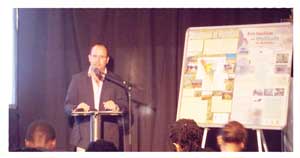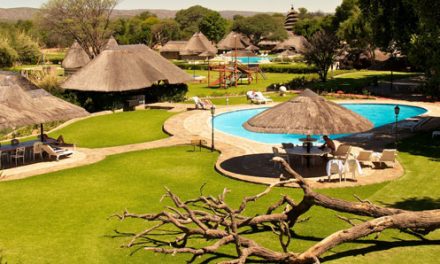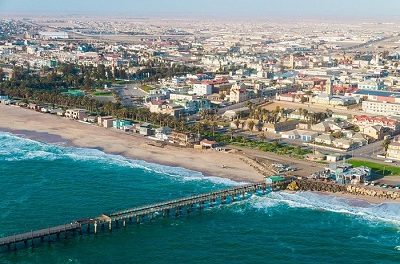
There is much more to wetlands than floods

Dr. Julian Fennessy, Technical Advisor to the Namibia Nature Foundation introducing the promotional posters during the launch.
In 2010, the Ministry of Environment and Tourism in partnership with the Namibia Nature Foundation and the Ramsar Convention Secretariat undertook a project on wetlands and their potential for eco-tourism.
The specific objectives of this project was to assess the current and potential uses and values of wetlands to local residents and the tourism industry, to raise the profile of target wetlands and increase awareness of local communities and the tourism sector of the value of wetlands and their potential for eco-tourism and finally to assess how wetland eco-tourism can improve the livelihoods of rural communities.
As part of the outcome of this project, promotional material in the form of brochures and posters were designed around a common theme. A documentary DVD on wetlands and eco-tourism was also developed with funding from the Strengthening of Protected Area Network (SPAN) Project, the Namibia Coastal Management (NACOMA) Project and the Namibia Nature Foundation.
To celebrate World Wetlands Day, the Ministry of Environment and Tourism held a joint launch of the wetlands and eco-tourism promotional material and biome posters as a demonstration of the country’s commitment to wetlands and water conservation. It is also seen as a first tentative step to improve wetland perceptions in rural communities.According to Louisa Mupetami, Director of Scientific Services in the Ministry of Environment and Tourism, the fact that many of Namibia’s wetlands are ephemeral and rather temporary, such as Etosha Pan, makes it even more complicated to view them as productive and valuable ecosystems.
“But it is exactly these rivers that provide numerous opportunities for rural development and job creation because they flow through communal land, have huge seasonal floodplains, and provide abundant resources and tourism opportunities,” said Mupetami, who was speaking on behalf of Deputy Minister of Environment and Tourism, Pohamba Shifeta,
In its efforts to promote sustainable management of wetlands according to international best practices, the Cabinet has approved a request by the ministry to list the lower section of the Kavango River as a Ramsar Site.
“We are working very hard to get all necessary paperwork done to get the site listed with the Ramsar Convention. I hope to have this process finalised by March this year. We are also working now on development of site specific management plans for the Orange River Mouth Ramsar Site and will soon start with developing one for the lower Kavango site,” Mupetami said.
The work on the two biome poster was supported by a number of organisations including the Namibia Nature Foundation, Go Green Fund of Nedbank Namibia, NamibRand Nature Reserve and Namibia Environment and Wildlife Society.













































